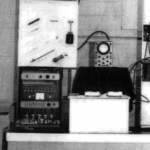video game
“There is no such thing as magic, supernatural, miracle; only something that's still beyond logic of the observer.” -Toba Beta
It might be hard to believe, but science tells us truths about the Universe that we might never have intuited or philosophized about if the Universe itself didn't reveal them to us through investigation. Bap Kennedy alludes to this in one of my favorite songs by him,
Mostly Water,
and this is certainly true of Einstein's relativity, which details just how the Universe behaves when we move close to the speed of light. This is notoriously difficult to…
Earlier this month, BNL physicist Peter Takacs told you about his progress in resurrecting one of the world's first video games. And you wanted to know, "How do I do that?"
Based on feedback from that post, we've uploaded the original high-resolution schematics for Tennis for Two to the end of this story on Brookhaven's website.
An original schematic for Tennis for Two
We've also included notes from the game's inventor, William Higinbotham, as well as the deposition he gave during a legal battle over the first video game patent (held by Magnavox). So start searching for an analog…
This guest post is written by Peter Takacs, a physicist in Brookhaven Lab's Instrumentation Division. Takacs, who earned his Ph.D. from Johns Hopkins University, joined Brookhaven in 1979.
Peter Takacs
More than a half-century ago, Brookhaven Lab nuclear physicist Willy Higinbotham sought to "liven up the place" with an experiment in entertainment. At BNL's annual open day in 1958, Higinbotham created what is often credited as the world's first video game. Hundreds waited in line for a chance to play "Tennis for Two," an interactive game made from an analog computer, two chunky…

